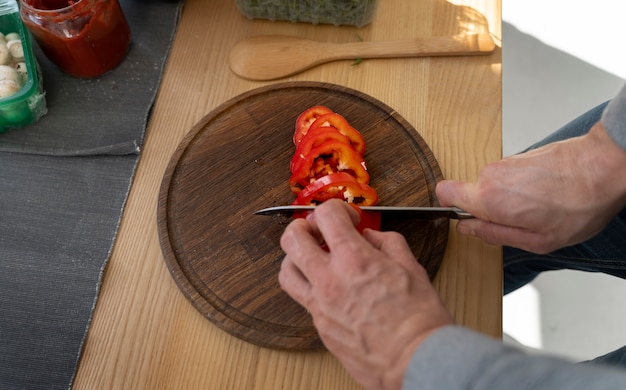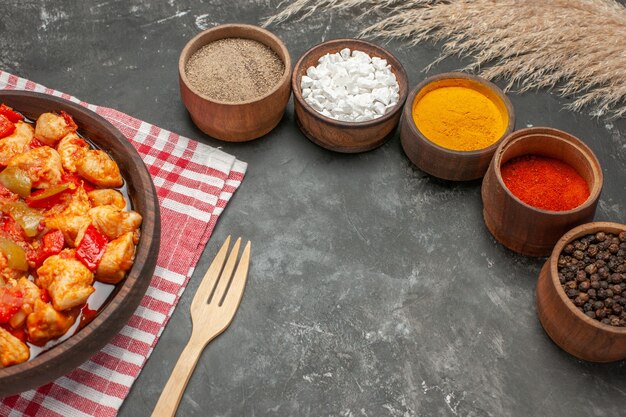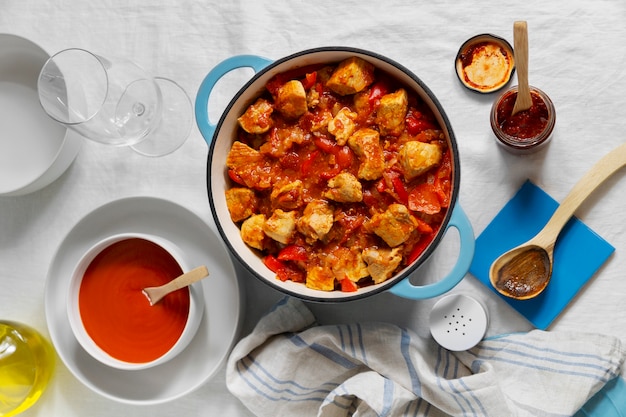Let's talk crawfish etouffee. It's one of those dishes that just screams "Louisiana," and it's a dish I've been making for years. I remember the first time I had it, down in New Orleans. It was a small, family-run joint, and the smell hit me the moment I walked in. I knew I was in for a treat. And let me tell you, I wasn't wrong. The rich, creamy sauce, the tender crawfish, the spicy kick – it was pure perfection. And that's what I'm aiming for here – that authentic Cajun flavor, right in your own kitchen.
So, settle in, grab a cuppa, and let me walk you through my version of this classic dish. I'm going to share all my tips and tricks, and by the end of this, you'll be whipping up etouffee like a pro.
Part 1: The Crawfish

You can't have etouffee without the star of the show: the crawfish. Finding the right crawfish is crucial. You want them fresh and plump, not watery and mushy. Here's how to ensure you're getting the best quality crawfish.
Choosing the Right Crawfish
If you're lucky enough to have a local seafood market, it's the best place to find fresh crawfish. But if you're buying frozen, make sure it's been thawed properly, and the tails are nice and firm. Here's a little trick: If you see a crawfish that's bright red, that's a sure sign it's fresh. And if the tail is curled under, that's another good indicator. It means the crawfish is plump and juicy.
Preparing the Crawfish
Once you've got your crawfish, it's time to prep them. A quick rinse under cold water and a good shake to get rid of any excess moisture is all you need. If you're using frozen crawfish, it's best to cook them first before adding them to the etouffee. This ensures they're properly cooked and ready to mingle with the flavors of the sauce.
Part 2: The Roux

Now, we're getting into the heart of the dish – the roux. It's the foundation of your flavor, and it's crucial to get it right. A roux is essentially a mixture of fat and flour, cooked together until it reaches a certain level of browning. The longer you cook it, the deeper the color and the more complex the flavor.
The Heart of the Etouffee
I'm a big fan of a dark roux for my etouffee. It takes a bit longer to make, but the flavor it brings is unmatched. It's the key to that rich, complex, and undeniably Cajun flavor.
Making the Roux
Start with a good amount of oil or butter – enough to cover the bottom of your pot. Slowly whisk in the flour, cooking over medium heat and stirring constantly. You'll notice the mixture start off smooth and light, but as it cooks, it'll thicken and turn a deep brown. Don't be afraid to let it get a little darker – that's where the richness comes in.
Tip: Patience is Key
The key to a good roux is patience. Don't rush it. If it starts to burn, take it off the heat for a few minutes, and then bring it back down to a low simmer. And remember, the darker the roux, the more intense the flavor.
Part 3: The Broth

Building the Flavor Base
Now, with our roux in place, we're going to add some flavor to this dish. The traditional Cajun way is to use a chicken stock or a combination of chicken and seafood stock. You want a good, rich stock with a bit of depth, and I always like to add a splash of white wine for a little extra complexity.
Tip: Homemade Stock vs. Store-Bought
Honestly, I'm a big fan of making my own stock, but I understand that sometimes you just need a quick fix. If you're using store-bought, make sure it's good quality. And if you're going for homemade, chicken and shrimp shells are the best ingredients for creating a truly authentic Cajun flavor. It's all about that extra layer of depth and richness.
Part 4: The Seasoning
Spicing It Up
Alright, time to add some spice! This is where the magic really happens. I use a blend of Cajun seasoning, cayenne pepper, and black pepper. The proportions are really up to your taste, but I like to keep it fairly spicy. Remember, you can always add more seasoning later, so start with a little and go from there.
Tip: Using Fresh Herbs
Now, if you want to take your etouffee to the next level, add some fresh herbs like thyme, bay leaves, and parsley. They give a beautiful aroma and complexity to the dish. Just remember to remove the bay leaves before serving.
Part 5: The Vegetables
Adding Texture and Flavor
For a truly authentic etouffee, you've got to include some vegetables. I typically use a combination of chopped celery, green onions, and bell peppers. They add a nice texture and a bit of sweetness to the sauce. Don't be afraid to get creative here. If you have some fresh garlic on hand, you can certainly add a couple of cloves, minced, for an extra kick.
Tip: Don't Overcook the Vegetables
The key is not to overcook the vegetables. You want them to be tender but still have a bit of bite. They should add to the overall flavor of the dish, not overpower it. A gentle simmer is all you need to bring out their best.
Part 6: The Crawfish (Again!)
The Final Touch
Now, it's time to add the crawfish! Remember, we're not just cooking them here, we're letting them mingle with the flavorful broth and infuse their essence into the sauce. Don't overcrowd the pot, though. Let those crawfish have some space to bask in the glorious flavors we've created.
Tip: Don't Overcook the Crawfish
Once the crawfish are in, you're looking for a gentle simmer, not a raging boil. Overcooked crawfish will be rubbery and dry, and that's not what we want. Just a few minutes is all you need to bring them to their tender, flavorful glory. Let the heat do its magic, and you'll be rewarded with perfectly cooked crawfish.
Part 7: The Finishing Touches
Adjusting the Seasoning
Now, before we serve this masterpiece, it's time to taste and adjust the seasoning. Remember, everyone's taste buds are different, so this is your chance to personalize your etouffee. If it's too spicy, you can add some more broth. If it's not spicy enough, add a pinch of cayenne pepper. A little bit of experimentation goes a long way!
Garnishing the Dish
Finally, we're ready to garnish. Now, I like to keep it simple: a sprinkle of fresh chopped parsley for a pop of color and a hint of freshness. But you can go all out if you want – diced green onions, chopped bell peppers, a squeeze of lemon juice – the possibilities are endless! Just remember to let the crawfish be the star of the show.
Part 8: Serving the Etouffee
The Big Reveal
Now, this is where the real fun begins. I like to serve my etouffee over a bed of white rice – it's the perfect way to soak up all that delicious sauce. But feel free to get creative. You can use it as a filling for po'boys, tacos, or even just a simple bowl of goodness.
Tip: Serving It Up Hot
Remember, etouffee is best served hot and fresh. So, get that pot bubbling, grab your favorite bowl, and get ready for a taste of Louisiana. Let the warmth and the aroma fill your senses and transport you straight to the heart of Cajun country.
Part 9: Variations
Playing with Flavor
Now, I know what you're thinking: "Etouffee is delicious, but how do I make it my own?" Well, the beauty of this dish is that it's incredibly versatile. Want to add a little seafood twist? Throw in some shrimp or crab. Feeling adventurous? Try some Andouille sausage for a smoky kick. The possibilities are truly endless.
Here are a few more variations to inspire your inner chef:
- Seafood Etouffee: Instead of crawfish, use shrimp, crab, or a combination of both. This creates a lighter and more seafood-forward flavor.
- Spicy Etouffee: For those who love heat, add a generous amount of cayenne pepper and even a pinch of hot sauce for an extra kick. You can also experiment with different types of chili peppers for additional flavor and spice.
- Vegetarian Etouffee: Replace the crawfish with hearty vegetables like mushrooms, tofu, or lentils for a plant-based version. Use a rich vegetable broth for the base and add your favorite herbs and spices for a delicious and satisfying meal.
- Creamy Etouffee: For a richer and creamier sauce, add a dollop of heavy cream or sour cream at the end of cooking. It creates a luxurious and decadent texture without overpowering the Cajun flavors.
Part 10: FAQs
Common Questions About Crawfish Etouffee
Alright, let's tackle some of those burning questions you might have about crawfish etouffee. I've got answers for you.
1. What if I can't find fresh crawfish?
No problem! You can absolutely use frozen crawfish. Just make sure it's thawed properly before you cook it. And don't worry, it'll still be delicious!
2. What's the best way to clean crawfish?
I keep it simple. A quick rinse under cold water, a shake to get rid of any excess water, and you're good to go. No need for complicated cleaning methods.
3. How do I know when my roux is ready?
It's all about the color! Your roux should be a deep, dark brown – almost like chocolate. It'll also be thick and fragrant. The aroma is a good indicator of its readiness.
4. How long should I cook the crawfish in the etouffee?
Not long at all! Just a few minutes to warm them up and let them infuse their flavor into the sauce. Overcooked crawfish will be rubbery and dry. You're aiming for tenderness and a gentle flavor infusion, not a rubbery mess.
5. What can I serve with my etouffee?
My favorite is white rice, but you can also serve it over pasta, cornbread, or even just a simple green salad. It's a versatile dish that can be enjoyed in many ways.
Part 11: The Importance of Crawfish Etouffee in Cajun Culture
Beyond being a delicious dish, crawfish etouffee holds a special place in Cajun culture. It's a dish that brings people together, whether it's a family gathering or a festive celebration. The process of making etouffee is a tradition that's passed down through generations, and the aromas that fill the kitchen as it cooks are a reminder of the rich heritage of cajun cuisine. So, when you're making etouffee, you're not just creating a meal, you're participating in a cultural experience.
Part 12: Final Thoughts
There you have it, folks! My take on a classic Cajun dish, ready to be made in your own kitchen. Now, go forth and conquer. And don't forget to share your creations – I'm always eager to see what you come up with. Happy cooking!
Everyone is watching

Prime Rib Roast Cooking Time Chart: Per Pound Guide
Cooking TipsPrime rib roast. Just the name conjures images of lavish dinners, crackling fires, and hearty laughter. It’s ...

How Long to Bake Potatoes in the Oven (Perfect Every Time)
Cooking TipsBaked potatoes are a staple in my kitchen. They're incredibly versatile, delicious, and surprisingly easy to m...

Perfect Rice Every Time: The Ultimate Guide to Cooking Rice
Cooking TipsAs a self-proclaimed foodie, I've always been a bit obsessed with rice. It's the foundation of countless cuisi...

The Ultimate Guide to Cooking Asparagus: Tips, Techniques, and Recipes
Cooking TipsAsparagus. The mere mention of this spring delicacy conjures up images of vibrant green spears, crisp and burs...

Ultimate Guide to Cooking the Perfect Thanksgiving Turkey
Cooking TipsThanksgiving. Just the word conjures up images of overflowing tables laden with delicious food, the scent of r...
